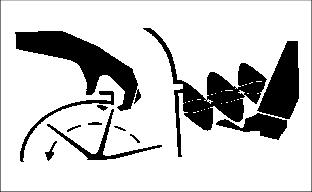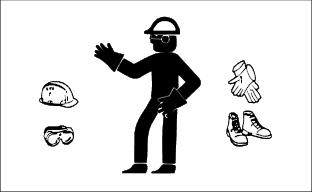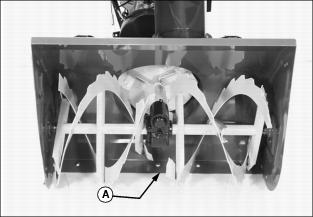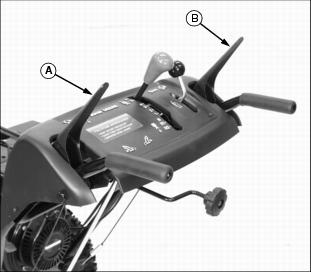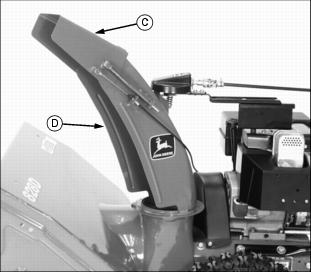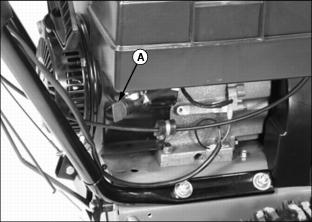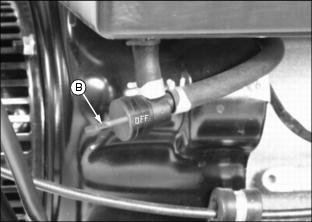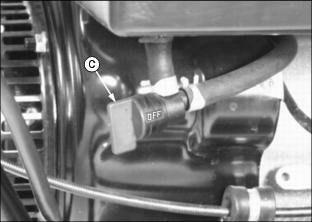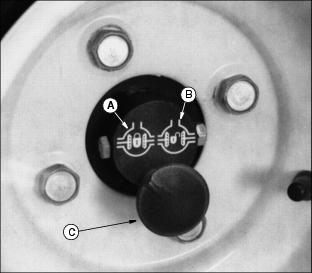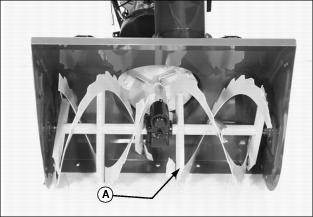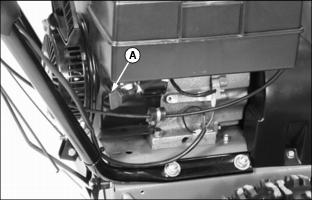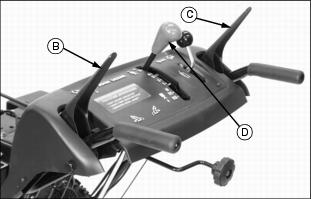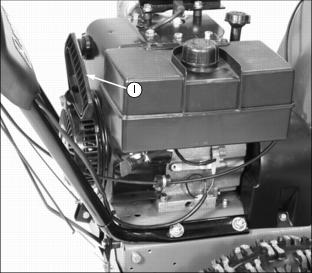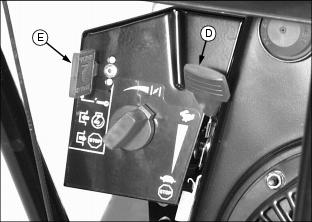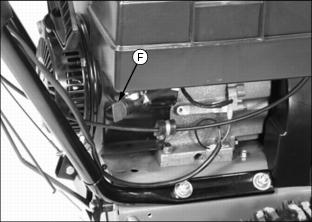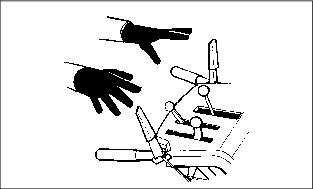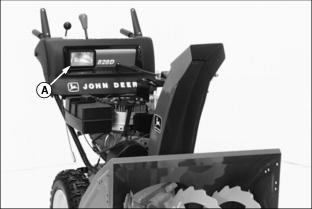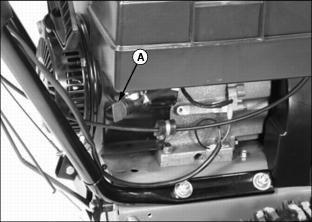Introduction
Safety Signs
Controls
Operating
Rotating Blades Are Dangerous - Protect Children And Prevent Accidents
Using Discharge Chute Controls
Avoid Damage To Plastic And Painted Surfaces
Replacement Parts
Service Machine Safely
Service Interval Chart
Service
Troubleshooting
Storing Machine
Assembly
Specifications
Warranty
John Deere Quality Statement
CopyrightŠ Deere & Company

Operating
Operate Safely
ˇ Inspect machine before you operate. Be sure hardware is tight. Repair or replace damaged, badly worn, or missing parts. Be sure guards and shields are in good condition and fastened in place. Make any necessary adjustments before you operate.
ˇ Clear work area of objects that might be thrown. Keep people and pets out of the work area. Stop machine if anyone enters the area.
ˇ If you hit an object, stop the machine and inspect it. Make repairs before you operate. Keep machine properly maintained and in good working order. Keep all shields and guards in place.
ˇ DO NOT blow snow toward people, cars, or buildings.
ˇ DO NOT use snowblower on surfaces above ground level, such as, a roof of a building.
ˇ Be extremely careful if you must clear snow from a gravel path. Be aware that snowblower may pick up gravel in snow. Adjust spout angle carefully to blow this snow safely.
ˇ DO NOT leave machine unattended when it is running.
ˇ Only operate during daylight or with good artificial light.
ˇ Be sure of footing. Operate slowly on slippery surfaces. Be especially careful when you pull machine backwards with the engine running.
ˇ DO NOT blow snow across a slope. Be careful when you change direction on a slope. Do not try to clear snow from steep slopes. Keep away from edge of a ditch or bank.
ˇ Keep a firm hold on the machine handles. Avoid sudden starts and stops.
ˇ DO NOT run engine in a building unless there is good ventilation.
Rotating Blades Are Dangerous - Protect Children And Prevent Accidents
PROTECT CHILDREN:
ˇ Never assume that children will remain where you last saw them. Children are attracted to snow blowing activity, stay alert to the presence of children.
ˇ Keep children in the house when you are operating the machine.
ˇ Turn machine off if a child enters the area.
ˇ Use extra care when you come to blind corners, shrubs, trees, or other objects that may block your vision.
ˇ DO NOT let children or an untrained person operate the machine.
HELP PREVENT SERIOUS OR FATAL ACCIDENTS:
ˇ Be alert at all times, people ESPECIALLY CHILDREN can move quickly into the area before you know it.
ˇ Shut off auger when you are not blowing snow.
ˇ Keep hands, feet, and clothing away from moving parts.
Wear Appropriate Clothing
ˇ Wear close fitting clothing and safety equipment appropriate for the job.
ˇ Loud noise can cause impairment or loss of hearing, wear a suitable protective device such as earplugs.
Adjusting Scraper Blade
1. Park snowblower on a hard, smooth surface.
2. Stop engine, remove key, wait for all moving parts to stop.
3. Remove wire from spark plug to prevent accidental starting.
4. Tip unit back onto handle bars and support housing.
5. Adjust skid shoes to their FULL UP position.
ˇ If scraper blade has excessive wear, replace it.
ˇ If scraper blade can be adjusted; loosen nuts and reposition scraper blade, flush with skid shoes.
8. Adjust skid shoes to the proper height. (See Adjusting Skid Shoes in this section).
Adjusting Skid Shoes
Adjust skid shoe height for proper working conditions:
1. Park snowblower on a hard, smooth surface.
2. Stop engine, remove key, wait for all moving parts to stop.
3. Remove wire from spark plug to prevent accidental starting.
ˇ Air pressure in both tires should be equal, although some machine leveling can be made by using different pressures.
ˇ Each tire must be resting on hard surface, not a cross-link of tire chain.
5. Put a block under auger housing.
ˇ If skid shoes have excessive wear, replace them.
ˇ If skid shoes can be adjusted; loosen two nuts (A) and move skid shoe (B) to desired position.
ˇ Tighten nuts. Adjust other skid shoe to the same height.
Using Drive Control Levers
TRACTION DRIVE LEVER (A):
ˇ Pull lever (A) to handle to ENGAGE the traction drive.
ˇ Release lever to DISENGAGE traction drive.
ˇ If auger drive lever (B) is also ENGAGED, you can release lever (B), auger drive will stay in the ENGAGED position. Release traction drive lever and both traction drive and auger drive will DISENGAGE.
ˇ Traction drive lever (A) will work independently from the auger drive lever.
AUGER DRIVE LEVER (B):
ˇ Pull lever (B) to handle to ENGAGE the auger drive.
ˇ Release lever to DISENGAGE auger drive.
ˇ If traction drive lever (A) is also ENGAGED, you can release lever (B), auger drive will stay in the ENGAGED position. Release traction drive lever and both traction drive and auger drive will DISENGAGE.
ˇ Traction drive lever (A) will work independently from the auger drive lever.
Using Speed Selector Lever
IMPORTANT: Avoid damage! DO NOT overload machine capacity by attempting to clear snow at too fast a rate. |
The speed selector lever (A) controls the units forward speed and reverse motion:
TO OPERATE SPEED SELECTOR LEVER:
ˇ With engine running, position speed selector lever in the notch of the desired speed and ENGAGE the traction drive lever (B).
ˇ DO NOT change forward speeds without declutching (releasing traction drive lever).
ˇ DO NOT change motion from forward to reverse with traction drive lever ENGAGED.
ˇ Release traction drive lever to STOP forward or reverse travel.
Using Discharge Chute Controls
ˇ DO NOT put hands or feet near or under rotating parts. |
DISCHARGE CHUTE
ˇ The discharge chute control (A) will rotate the discharge chute (D):
ˇ The discharge chute will rotate (full right, straight ahead, or full left).
CHUTE DEFLECTOR
ˇ The chute deflector lever (B) will control the chute deflector (C):
ˇ The chute deflector will determine how high or low snow will be thrown.
Using Fuel Shut Off
The engine in your snowblower is equipped with a two position fuel shut off valve (A).
CLOSED (OFF) position (B):
ˇ When performing any type of engine service.
OPEN position (C):
ˇ Fuel shut off valve must be in the full OPEN position for proper fuel delivery to the engine.
Using Differential Lock
To ENGAGE differential lock:
ˇ Pull knob (C) and turn to "LOCKED"position (A). Knob will snap in when positioned correctly.
ˇ Both drive wheels are now locked together for improved traction -turning will now be more difficult.
To DISENGAGE differential lock:
ˇ Pull knob (C) and turn to the "UNLOCKED" position (B).
ˇ This is the normal position to leave your unit in. Engine power will be going to both wheels through the differential - turning corners will now be easier
Pre-Starting Engine
IMPORTANT: Avoid damage! In very cold weather, check impeller to be sure it is not frozen. Starting with a frozen impeller could damage the unit. |
To check unit for a frozen impeller (A):
1. Disconnect spark plug wire from spark plug.
3. Pull engine rewind starter.
ˇ If impeller is frozen: Rewind starter can not be pulled. Move unit to a heated area so ice around impeller can thaw.
ˇ If Impeller is not frozen: Rewind starter can be pulled - it will be more difficult than normal.
Starting Engine
1. Check fuel shut off valve (A). Valve must be in the full OPEN position.
2. Traction drive lever (B) and auger drive lever (C) must be in the DISENGAGED position.
3. Speed selector lever (D) should be in the "N" NEUTRAL position.
NOTE: The engine ignition key is a two position PUSH/PULL design. DO NOT twist key after it is installed.
4. Install engine ignition key and PUSH it into the position.
ˇ "STOP" position. To disable the ignition system, PULL key all the way out.
5. Turn choke control knob (E) to choke engine. This engine is equipped with a three position choke:
6. Push primer bulb (F) to force fuel into the carburetor, be sure to cover VENT HOLE in primer bulb:
7. Move throttle lever (H) to set engine speed:
ˇ Pull starter handle (I) until you feel resistance within the engine.
ˇ Then pull handle fast and steady.
ˇ Do not let handle snap back.
ˇ Repeat steps 6 and 8 until engine starts.
If starter handle is frozen and will not crank engine:
ˇ Pull as much rope out of starter as possible.
ˇ Release starter handle and let it snap back against starter, repeat as required.
IMPORTANT: Avoid damage! The house circuit you use should be protected by a 20 amp fuse. ˇ A smaller fuse may burn out when you use the electric starter. |
NOTE: The electric starter motor will shut off automatically if it overheats from cranking the engine. After the motor cools, it will operate again.
ˇ Connect power cord to engine switch box (A).
ˇ Plug other end of cord into three-hole, grounded 120-volt AC. receptacle.
ˇ Push starter button (B) to start engine.
ˇ Disconnect cord from house circuit FIRST. Then disconnect cord from switch box.
ˇ Slowly move choke knob to the "OFF" position.
ˇ Slowly move throttle lever to desired engine speed.
Stopping Engine
Follow steps below before you park, inspect, adjust, or unplug snowblower.
1. Release traction drive lever (A) and auger drive lever (B). Snowblower will STOP and auger/blower will STOP.
2. Put speed selector lever (C) in the "N" NEUTRAL position.
3. Slowly move throttle lever (D) to the "STOP" position. Engine will stop.
NOTE: The engine ignition key is a two position PUSH/PULL design. DO NOT twist key after it is installed.
4. Pull engine ignition key (E) out.
ˇ "STOP" position. To disable the ignition system, PULL key all the way out.
5. Move fuel shut off valve (F) to the CLOSED (OFF) position. (See Using Fuel Shut Off Valve in this section).
Emergency Stopping
To STOP snowblower in an emergency, RELEASE LEVERS.
This will:
ˇ STOP auger. If the auger does not come to a complete STOP in 5 seconds or less after the auger drive lever is released. (See Checking Clutch / Impeller Brake in the Service section).
Using Headlight
Headlight (A) will remain "ON" as long as the engine is running.
Daily Operating Checklist
Avoid Damage To Plastic And Painted Surfaces
Be careful not to spill fuel on machine. Fuel may damage surface. Wipe up spilled fuel immediately
Transporting
TRANSPORTING A SHORT DISTANCE:
ˇ When transporting unit to and from area to be cleared, press down on handlebars enough to raise front of snowblower slightly off surface.
ˇ Engage traction drive lever to propel unit. Do not engage auger drive while transporting.
TRANSPORTING A LONG DISTANCE:
ˇ When transporting this snowblower on a trailer or in a truck, make sure unit is secured to prevent it from sliding or tipping over.
ˇ Move fuel shut off valve (A) to the CLOSED (OFF) position (B). (See Using Fuel Shut Off Valve in this section).
Snowblowing Tips
ˇ For best snowblower performance, run engine with throttle lever in the FAST position.
ˇ Do not operate unit at high transport speeds on slippery surfaces and use care when backing.
ˇ Do not overload machine capacity by attempting to clear snow at too fast a rate.
ˇ Match ground speed to amount of snow to be moved. Example: Low speed (1) is recommended for removing deep or hard packed snow.
ˇ Clear snow immediately after it falls, if possible.
ˇ Blow snow downwind, if possible.
ˇ Overlap each swath slightly for complete snow removal.
ˇ Run snowblower a few minutes after blowing snow to prevent freeze up of auger/impeller.
ˇ Pull the starter handle several times to help prevent moisture in the starter from freezing.


